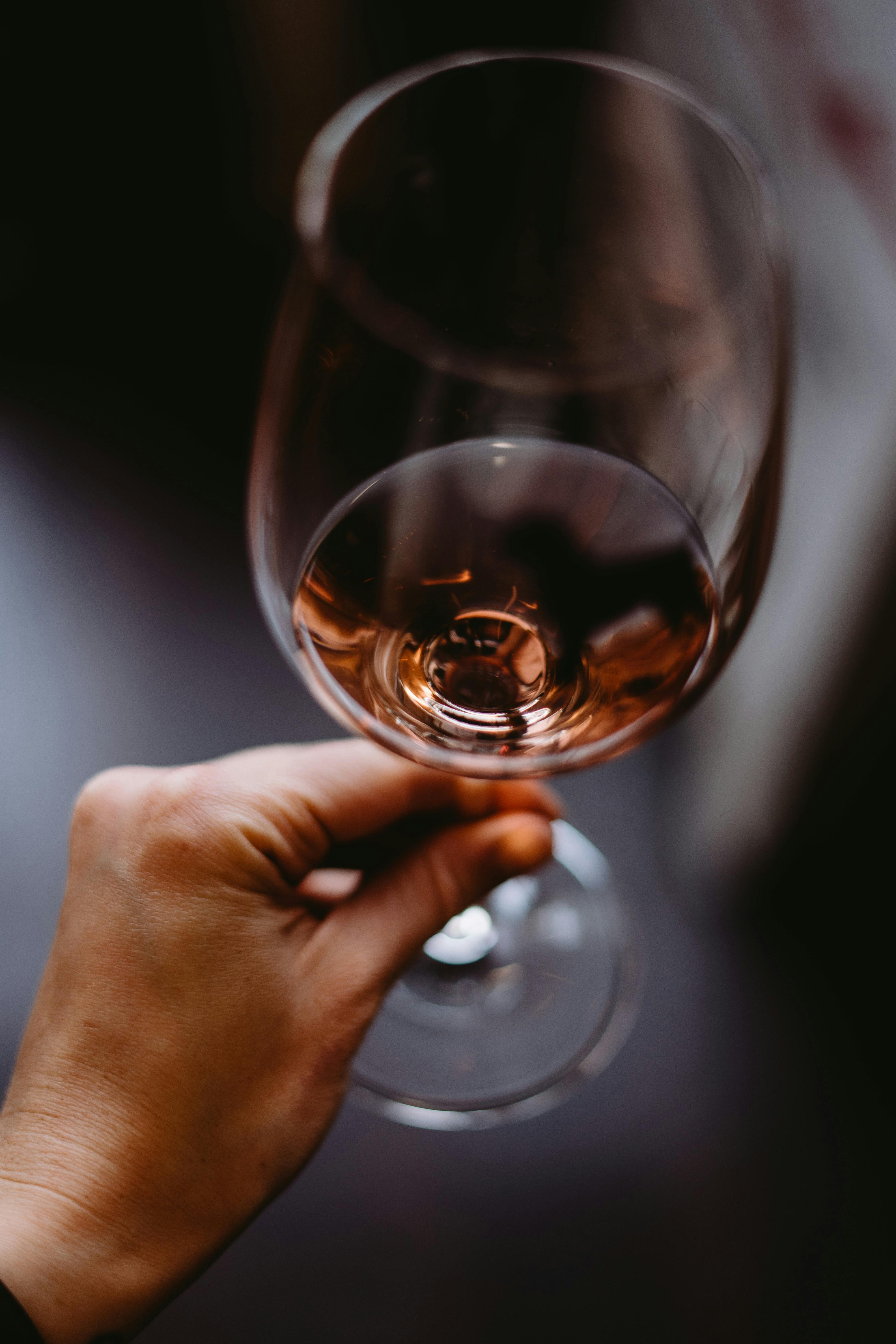Rosé and blush wines are both light, pink-colored wines. However, there are some notable differences between the two.
The primary difference between rosé and blush wine is in the production method. Rosé is made by leaving the juice in contact with the skins of red grapes briefly, while blush wines are usually made from adding a small amount of red wine to white wine or from fermenting red and white grapes together.
The color of rosé wine ranges from a pale orange to a vivid pinkish-purple, while blush wines tend to be much lighter in color. Rosé wines also tend to have more body than blush wines and often offer more robust fruit flavors.Rosé wine is a type of wine made from red grapes with a pink color. It is created by leaving the grape skins in contact with the juice for a short period of time during fermentation, resulting in an attractive blush color. Rosé can vary in sweetness, from dry to sweet, and can be produced still, semi-sparkling or sparkling. It is usually enjoyed chilled and pairs well with light meals such as salads and seafood.
Rosé wines are made from any number of grape varieties and are produced in almost every major wine producing region around the world. Popular varieties include Grenache, Syrah/Shiraz, Pinot Noir and Cabernet Sauvignon. Depending on the variety used, it can have flavors ranging from strawberry or raspberry to melon or citrus.
Rosé is becoming increasingly popular among wine drinkers due to its freshness, versatility and affordability. The most popular styles are dry rosés which pair well with light summer fare such as salads and grilled fish or poultry. Sweet rosés are also popular for their fruity taste and are often served as an aperitif or dessert wine.
Contents
What is Blush Wine?
Blush wine, also known as rosé, is a type of wine that is made by allowing the grape skins to briefly touch the juice before it is fermented. The result is a pink-colored wine that tends to be sweeter than other types of wines. It has become increasingly popular in recent years and can be found in many different varieties. Blush wines are typically light-bodied, low in tannins and alcohol, and have delicate aromas and flavors. They range in color from light pink to deep ruby hues. Blush wines are often described as having notes of strawberries, raspberries, cherries, watermelon, and other fruits. They can be enjoyed on their own or paired with foods like salads, seafood dishes, or desserts.
How Do You Make Rosé Wine?
Making rosé wine is a relatively easy process that starts with the same steps used to make red and white wines. First, the grapes are picked and crushed to release their juices. After fermentation, the young wine is then aged in oak barrels or stainless steel tanks. Depending on the desired flavor profile, winemakers may choose to blend different types of red and white grapes.
The key difference between rosé and other wines is that it must have a distinct pink hue. This pink color comes from contact with the skins of red wine grapes during fermentation. Winemakers can control how long this contact period lasts in order to achieve different shades of pink. The longer the contact period, the deeper the color will be.
When making rosé, fermentation can take place using either warm or cool temperatures depending on the desired flavors and aromas in the final product. After primary fermentation is complete, secondary fermentation may be used to further enhance aromas and flavors in the wine. Finally, winemakers can choose to age their rosé for a few months or longer before bottling it for sale.
Overall, making rosé wine is easy if you understand what steps are involved and how they affect flavor and color of your final product. With careful planning and attention to detail during each step of production, you can make a delicious bottle of rosé that will be enjoyed by your friends and family!
How Do You Make Blush Wine?
Blush wine is a type of white or rose wine that has a sweet, fruity flavor. It is often made with red grapes and can range from dry to sweet in taste. To make blush wine, you will need the following ingredients: red grapes, yeast, sugar, and water. You will also need some basic winemaking equipment such as a fermenter, carboy, siphon tube, and bottles for bottling your finished product.
First, you will need to crush the grapes and place them in a fermentation vessel. Then add the yeast and sugar. The sugar will provide food for the yeast to consume and create alcohol during fermentation. Once added, seal the fermenter with an airlock or other device to allow CO2 gas to escape while preventing oxygen from entering the vessel.
Next, you will need to let the wine ferment for several weeks at a temperature of around 18-22°C (64-72°F). During this time you should check on it regularly and give it a stir if needed. After fermentation is complete, you can transfer your blush wine into a carboy or other storage vessel for aging and clarification.
Once your blush wine has aged and clarified sufficiently, it’s time to bottle it up! Before bottling your wine make sure to test it first to see if it needs any additional sugar or acidity adjustments. When ready for bottling simply use a siphon tube to transfer your wine into bottles with corks or screw caps for storage. And voila – you have now made your own blush wine!
What Grapes are Used to Make Rosé Wine?
Rosé wine is made from a wide variety of grape varieties. These include Pinot Noir, Syrah, Grenache, Mourvèdre, Cabernet Sauvignon, Merlot and Cinsault. Each of these grapes contributes different characteristics to the final product, making for a complex and interesting wine. Pinot Noir gives the wine its delicate pink hue and light body. Syrah provides dark color and robust tannins while Grenache adds a fruity aroma and soft texture. Mourvèdre brings pronounced aromatics and spice while Cabernet Sauvignon contributes hints of violet, tobacco and earthiness. Merlot adds structure while Cinsault offers bright acidity and floral notes. Together these grapes create a well-balanced rosé that is sure to please any palate.
In addition to the traditional red grapes used in rosé production, some winemakers are now experimenting with white varietals such as Chardonnay or Sauvignon Blanc. These wines tend to be lighter in color but still maintain their characteristic crisp acidity and subtle fruit flavors. In some cases, winemakers may blend both white and red grapes to create a unique rosé with more complexity than either could offer on its own.
No matter which grapes are used to make it, rosé is an incredibly versatile wine that can be enjoyed year-round. Whether you’re looking for something light and refreshing or something more robust with plenty of structure, there’s sure to be a rosé out there that fits your tastes perfectly!

What Grapes are Used to Make Blush Wine?
Blush wines are typically made from red grape varieties, but the skins are removed shortly after crushing to prevent any color from transferring to the wine. This process is known as “bleeding” and the resulting wines tend to be pale pink or light salmon in color. Popular grape varieties used for blush wines include Syrah, Zinfandel, Grenache, and Mourvèdre. White varietals such as Chardonnay, Sauvignon Blanc, and Pinot Grigio may also be used for blush production.
When making blush wine, winemakers will often blend different grape varieties together to achieve the desired flavor profile. For example, a French rosé might be blended with Syrah and Cabernet Sauvignon while an Italian rosato could be blended with Sangiovese and Barbera. The exact blend will depend on the style of wine being produced and the winemaker’s personal preference.
In some cases, a single variety of red grapes may be used for blush production. This is often done when making wines with intense aromas and flavors such as Grenache or Mourvèdre-based rosés from Spain or Portugal. These wines tend to have a deep pink hue due to the fact that more color has been extracted from the skins before pressing.
What Color is Rosé Wine?
Rosé wine is a type of wine that is known for its characteristic pink color. The color of rosé wine can range from a very pale pink to a deep, dark pink. The color of the wine depends on the type of grape used and how long the juice has been in contact with the skins.
Rosé wines are made by allowing some of the juice from red grapes to remain in contact with the skins for a short period of time. This gives the juice a hint of color and flavor from the skins, resulting in its characteristic pink hue. The amount of time that the juice remains in contact with the skins determines how dark or light in color it will be.
The most common types of grapes used to make rosé wine are Grenache, Syrah, Mourvedre, Cinsault, and Pinot Noir. These grapes typically produce wines that are light to medium-bodied with aromas and flavors of berry fruits, citrus fruits, and herbs.
In addition to its beautiful range of colors, rosé wines have many other appealing qualities such as their ability to pair well with food or stand alone as an aperitif. They are also very versatile and can be served chilled or at room temperature depending on your preference.
Whether you’re sipping it solo or enjoying it with friends at dinner, rosé wine is an ideal way to enjoy any occasion!
What Color is Blush Wine?
Blush wine is a type of light-bodied, semi-sweet and slightly sparkling wine. It has a distinct pinkish color, making it the perfect choice for those who want to enjoy a sweet and fruity beverage without sacrificing their sophisticated palette. Blush wine has become an increasingly popular choice among oenophiles and casual drinkers alike, as it pairs well with many dishes.
The color of blush wine can vary from light pink to deep magenta, depending on the grapes used in its production. The most common blush wines are usually made from Pinot Grigio or Zinfandel grapes, both of which have a light pink hue when vinified. Other grapes used to make blush wines include Gamay and Syrah, both of which yield a slightly darker shade of pink.
The sweetness level in blush wines can also depend on the type of grapes used and the amount of sugar added during fermentation. Generally speaking, sweet blush wines are more likely to be made with white grapes such as Pinot Grigio or Moscato while drier varieties will usually use red grapes like Zinfandel or Syrah.
Overall, blush wine is a light-bodied, semi-sweet and slightly sparkling wine with a distinct pinkish color that can range from light pink to deep magenta depending on the type of grape used in its production. Its popularity continues to grow due to its versatility in pairing with many dishes or simply enjoyed as an aperitif by itself.

Conclusion
In conclusion, Rosé wine and blush wine are two distinct types of wine. The color and flavor of each vary depending on the grapes used in production. Rosé is typically made from red grapes while blush is usually made from white grapes. Rosé wines tend to be more complex and dry while blush wines tend to be sweeter and fruitier. Blush wines also have a higher alcohol content than Rosé. Ultimately, the choice between the two comes down to personal preference and desired flavor profile.
No matter which type of wine you choose, both offer unique flavors and aromas that will enhance any occasion or meal. Enjoy exploring the world of wine!
0 Comments